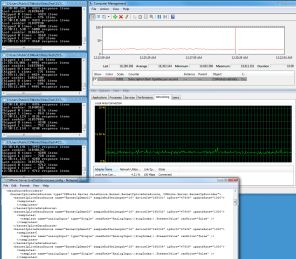BACnet IP performance - Lab 05
Author: John Doe
Published: 2011-07-19 22:31:00
Last update: 2013-10-16 17:22:16
Tags: bacnet
performance
updates
analog inputs
Slug: BACnet-IP-performance-Lab-05
If you are curious how well our new BACnet IP implementation can perform, you may find this post interesting. I used CSWorks 2.0.4115.0 LiveData Service installed on a Core2 Quad Q6600 @2.40 GHz machine with 4GB RAM running 64-bit Windows 7. As a testing client, I used four instances of a simple LiveData client application that subscribes to updates from 5000 BACnet analog inputs, requesting for updates every second. Test applications talks to CSWorks LiveData Service directly over WCF (exctly the same way WCF LiveData Agent demo does). All hardware is connected via 100mb Ethernet.
My LiveData Service config file referenced four BACnet IP datasources, from "BacnetIpDemo01" to "BacnetIpDemo04" with ids from 260001 to 260004, you can see correspondent fragment of the config file on the screenshot below.
Test application expected every analog input data item to change on every update request. If a data item is not changed, the test application increases item's "skip" count. In the ideal world, skip count for all data items would be zero, since every BACnet device changes every item once a second. But due to the discretization process that occurs twice (once between LiveData Service and the BACnet device, another time between the client application and the server) it is hard to avoid these misses.
Performance monitors shows an average rate of ~18000 updates per second. If there was no device-to-server discretization and UDP packet loss, the rate would be exactly 20000 updates per second. LiveData Service was consuming 5-7% CPU.

